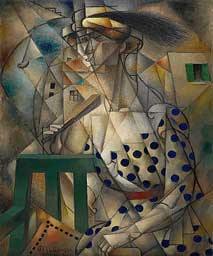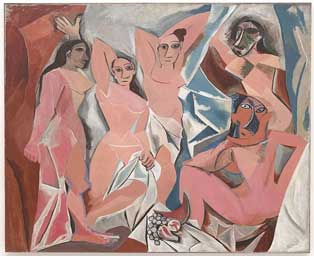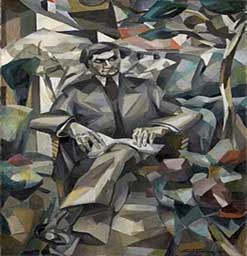
Cubism Introduction
Welcome to this month’s Oil Painting Blog. *
Last month, we looked at Post-Impressionism and artists such as Van Gogh, Gauguin and Cezanne.
This month, we will be focusing on another key artist movement – Cubism.
I think this is a natural progression, given that, it is often said that the work of Cezanne set the stage for Cubism. In 1907, a year after his death, a landmark retrospective of his artwork was held at the Salon d’Automne, this proved to have a lasting impact on many influential artists of that time. These artists would go on to echo Cezanne’s train of thought – that all-natural forms could be analysed as cylinders, spheres or cones [1] – essentially, geometric reductions – known as Cezanne Cubism or Proto Cubism.[2]
Cubism was a movement that broke with academic tradition. All rules of modelling, foreshortening and perspective developed and established since the time of the Renaissance masters [3], were basically fired out the window, and completely rejected by all those involved in this art movement.
Instead, over a relatively short period of 6 years (1908 – 1914), Cubists began to analyse structure, simplifying it to a two-dimensional form, but at the same time, fracturing it from multiple viewpoints – this was Stage One – known as ‘Early Cubism’ or ‘Analytic Cubism’ (1908 – 1912).

Girl with a Mandolin
(Fanny Tellier)
Pablo Picasso
1910

Rhum et Guitare
(Rum and Guitar)
Georges Braque
1918
Colección Abelló, Madrid
Initially, Cubists used a limited colour pallet but as the movement develop so to, did their use of colour and style, which also underwent a further simplification of form – this was Stage Two – known as ‘Late Cubism’ or ‘Synthetic Cubism’ (1912-1914).

Les Baigneuses
(The Bathers)
Albert Gleizes
1912
Musee d’Art Moderne de la Ville de Paris

Femme à l’Éventail
(Woman with a Fan)
Jean Metzinger
1912
Solomon R. Guggenheim Museum
After 1914, Cubism developed into the overlapping of geometric planes and flat surfaces known as ‘Crystal Cubism’ (1914 – 1918). Thereafter, it went on to influence many new art movements.

Soldat jouant aux échecs
(Soldier at a Game of Chess)
Jean Metzinger
1914-15
Smart Museum of Art
Cubism – The Beginning
In 1907, Picasso painted Les Demoiselles d’Avignon.

Les Demoiselles d’Avignon
Pablo Picasso
1907
Museum of Modern Art, New York
It took 9 months to complete, and, at the time, was called the most innovative painting since the work of Giotto. [4]
Initially, inspired by Picasso’s fascination with Iberian sculpture and African and Oceanic masks, it depicts a group of nude prostitutes in a brothel in Avignon, Barcelona’s red-light district. The painting is often seen as the starting point for Cubism. [5] It went on to influence Charles Braque, initially a sceptic, like many artists close to Picasso, however, after painting a large nude himself under the influence of this painting, he became a co-creator with Picasso, and together they pushed visual representation to its limits. [6]

Pablo Picasso
(1881 – 1973)

George Braque
(1882 – 1963)
© National Portrait Gallery, London
Inspired by the work of Picasso and Braque, another group of artists, including André Lhote (1885 – 1962) and Albert Gleize (1881 – 1953), helped bring the movement forward, by employing bright colours and paying homage to Cezanne.

French Landscape
André Lhote
1912
Musée des Beaux-Arts de Bordeaux

Portrait de Jacques Nayral
Albert Gleizes
1911
Tate Modern, London
However, their exhibitions at the Salon des Independents of 1911 and 1912, were a public scandal, with the artworks being considered as shocking, radical, and leading to questions being asked in government in protest of this apparent waste of money. [7] This all helped however to bring the movement to the attention of Paris and in 1912, the first book on the subject was published by Gleizes and Jean Metzinger (1883 – 1956).
Cubism – The Ending?
With the onset of the Great War in 1914 – 1918, Cubism became less popular.
Many of the artists involved in the movement, had been conscripted into the French Army including Braque who suffered a head wound and parted ways from Picasso thereafter.
Following the War, there was a widespread reaction against Cubism – sometimes called the “Return to Order” [8]. It was the overall impact of trench warfare and the destruction of the human body on an unprecedented scale, that perhaps led to this “Return to Order” and a “Return to Figuration” [9] in the art world.
However, that being said, Cubism, laid the groundwork for the next 50 years in 20th Century Modern Art, influencing many new art movements including, Futurism, Surrealism, Dada, De Stijl, Bauhaus and Abstract Expressionism.
Cubism and the Irish
After the War ended, it was once again safe for Irish artists to travel and train in Paris. Most notably May Guinness, Jack Hanlon, Evie Hone, Mainie Jellett, Nora McGuinness and Mary Swanzy.
Between 1920 – 1930’s, many of these artists trained and/or were heavily influenced by Lhote and Gleizes and this also helped in the continuation of the Cubist movement.

Oil Painting à la mode d’André Lhote
Mary Swanzy
undated
Drogheda’s Municipal Art Gallery

Homage to Fra Angelico
Maine Jellett
1928
Image from Adams Catalogue
If you would like to learn more on Cubism, the Crawford Art Gallery, Irish Museum of Modern Art and the F.E. McWilliam Gallery & Studio together published Analysing Cubism which is well worth a read.

We will be taking our summer break in June and July. However, our oil painting blogs will be back again on the last Tuesday in August, where we will be looking at some key artists and how their painting style changed over the course of their lives.
Until then have a great Summer!!
Emily
May 2022
* As always, I am not affiliated with any brands, stores, or persons I may or may not mention and your use of any of these products, links and the like are your own risk and it’s up to you to do your research/homework before you use them. This is just my opinion and experience.
[1] Paul Cézanne, Letters, ed. John Rewald, 4th ed., New York, 1976, p. 301
[2] Abstract Painting and Sculpture, Crystal Cubism (1915 – 1916), http://www.abstractpaintingsandsculpture.com/artist/crystal-cubism-art-1915-1916/
[3] Kissane S., Analysing Cubism, (Pub Crawford Art Gallery 2013) p.12
[4] Payne, L., Essential Picasso, 1st edn (2000) (Parragon), p.60.
[5] Hodge, S., Everything you need to know about the greatest artists and their works, 2nd Edn (Quercus Editions Ltd) (2013), p.186
[6] Artists, Their Lives and Works, 1st edn (2017) (DK Penguin Random House) p.291
[7] Kissane S., Analysing Cubism, (Pub Crawford Art Gallery 2013) p.13
[8] A, Graham-Dixon, ‘Art – The Definitive Visual Guide’ (1st edn, Penguin 2008) p.416
[9] Kissane S., Analysing Cubism, (Pub Crawford Art Gallery 2013) p.14
Become an insider, subscribe to receive
Stunning previews of new art, discounts, painting tips and early booking for painting workshops.



